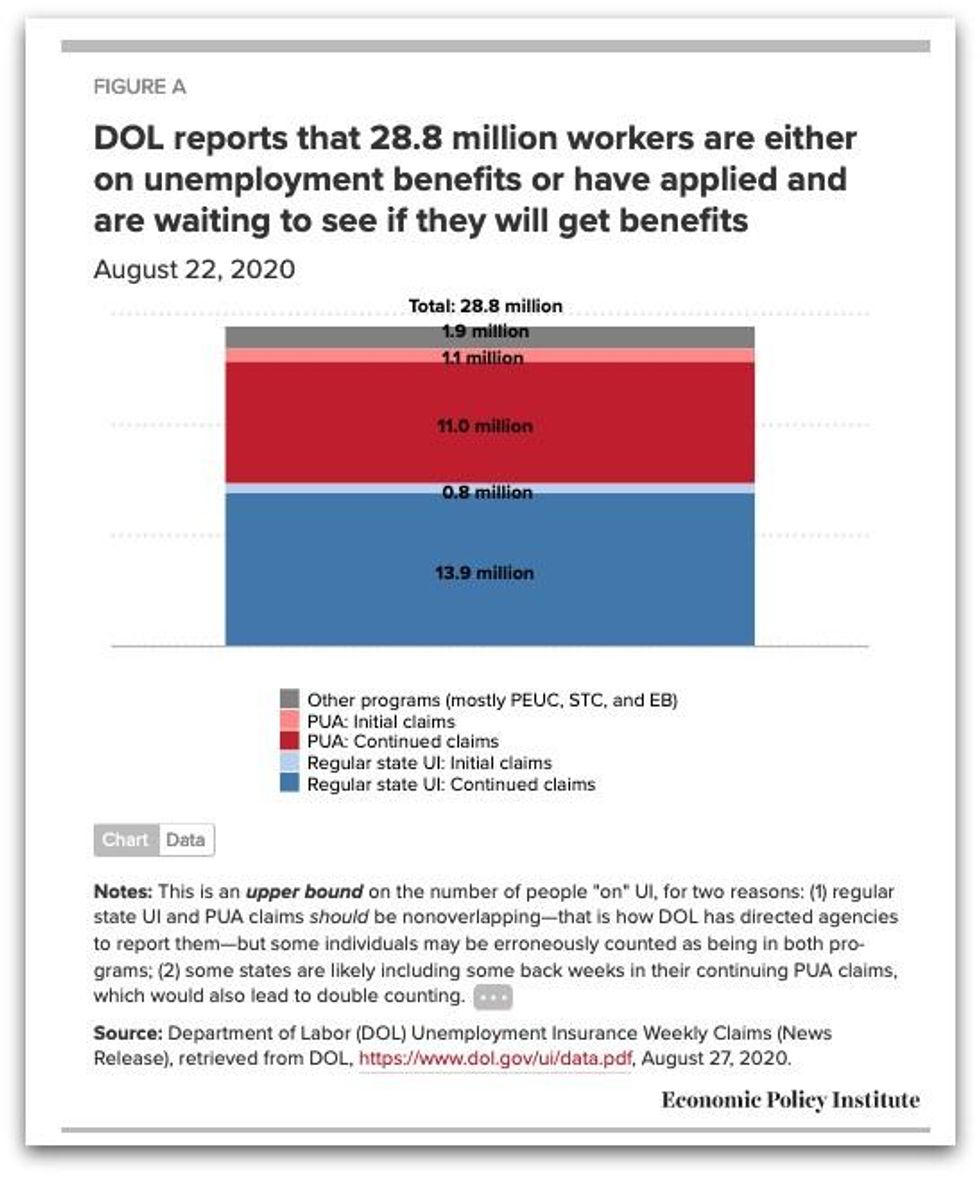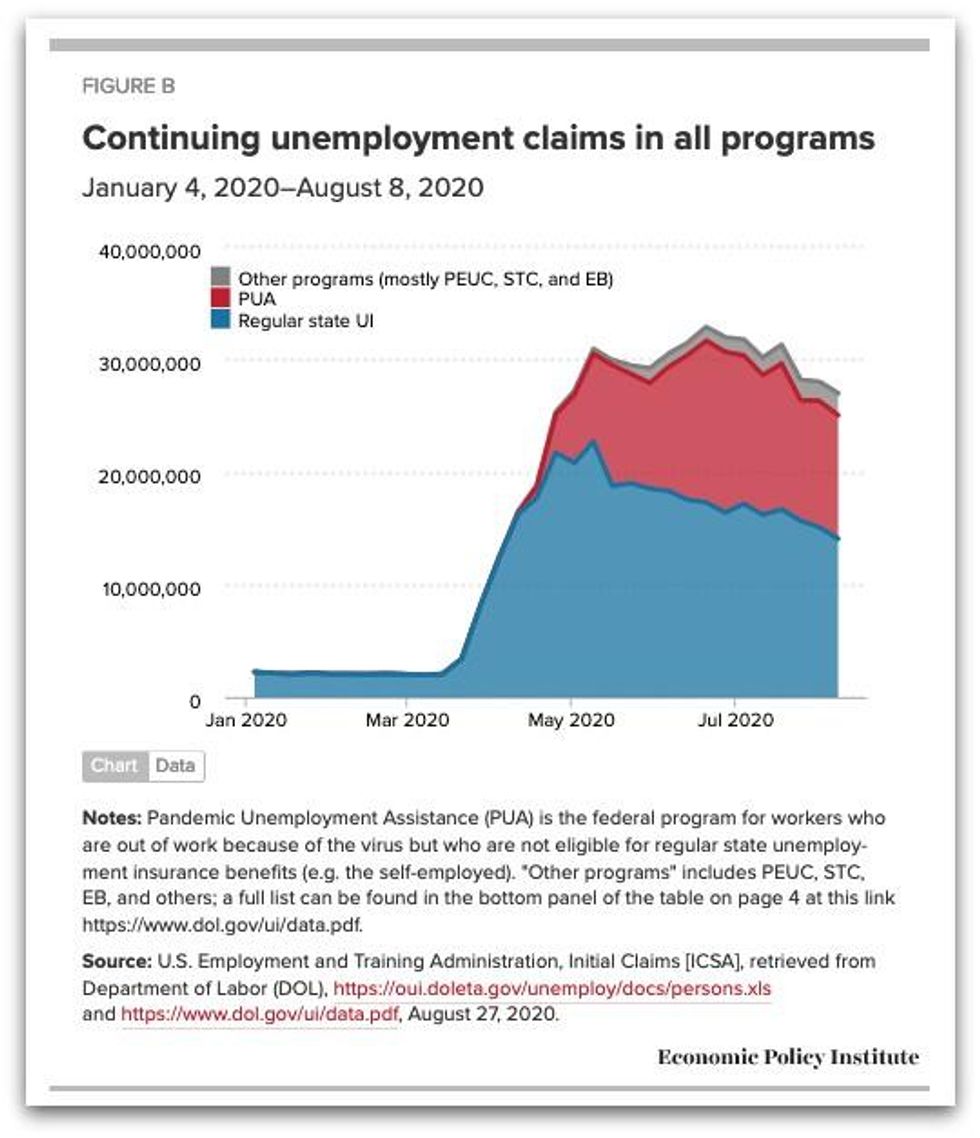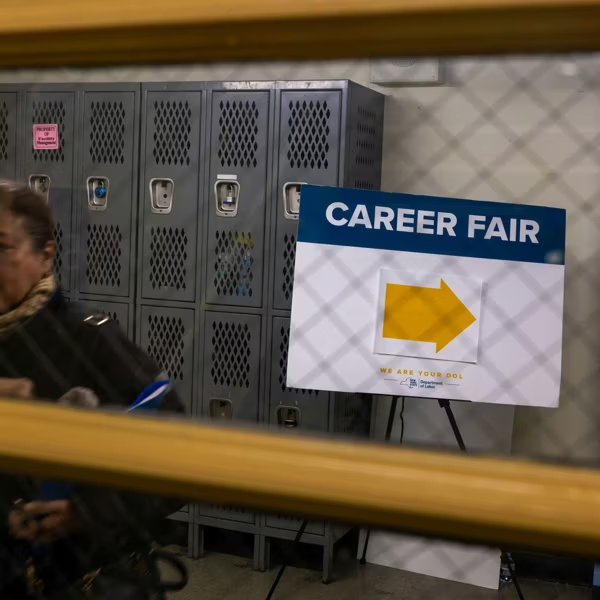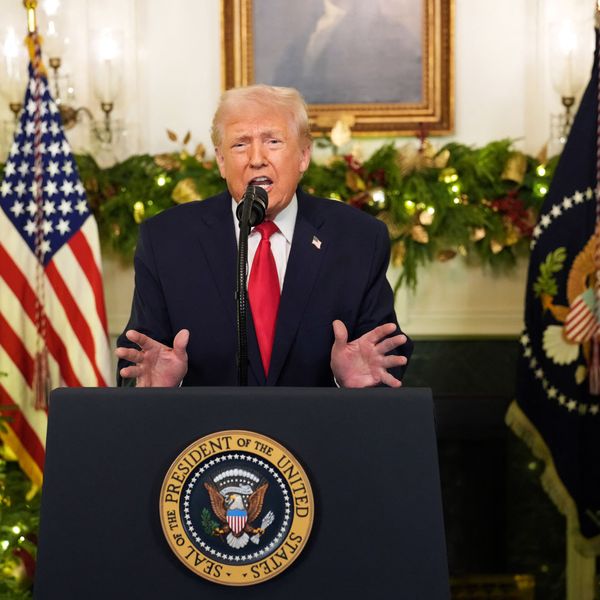
Senate Majority Leader Mitch McConnell (R-Ky.) conducts a news conference after the Senate Republican Policy luncheon in the Hart Building on Tuesday, July 21, 2020. (Photo: Tom Williams/CQ-Roll Call, Inc. via Getty Images)
UI Claims Remain Historically High and the President's Executive Memorandum Is Doing More Harm Than Good
Congress must reinstate the extra $600.
Last week 1.4 million workers applied for unemployment insurance (UI) benefits. Breaking that down: 822,000 applied for regular state unemployment insurance (not seasonally adjusted), and 608,000 applied for Pandemic Unemployment Assistance (PUA). Some headlines this morning are saying there were 1.0 million UI claims last week, but that's not the right number to use. For one thing, it ignores PUA, the federal program that is serving millions of workers who are not eligible for regular UI, like the self-employed. It also uses seasonally adjusted data, which is distorted right now because of the way the Department of Labor (DOL) does seasonal adjustments. One bit of good news is that with today's release, DOL announced that starting next week, they will be changing the way they do seasonal adjustments. The change should address the issues that have plagued seasonally adjustments during this pandemic.
Republicans in the Senate allowed the across-the-board $600 increase in weekly UI benefits to expire. Last week was the fourth week of unemployment in this pandemic for which recipients did not get the extra $600. That means people on UI are now are forced to get by on the meager benefits that are in place without the extra payment, benefits which are typically around 40% of their pre-virus earnings. It goes without saying that most folks can't exist on 40% of prior earnings without experiencing a sharp drop in living standards and enormous pain.
Earlier this month, President Trump issued a joke of an executive memorandum. It was supposed to give recipients an additional $300 or $400 in benefits per week. But in reality, even this drastically reduced benefit will be extremely delayed, is only available for a few weeks, and is not available at all for many. The executive memorandum is a false promise that actually does more harm than good because it diverts attention from the desperate need for the real relief that can only come through legislation.
"The executive memorandum is a false promise that actually does more harm than good because it diverts attention from the desperate need for the real relief that can only come through legislation." This is cruel, and terrible economics. The extra $600 was supporting a huge amount of spending by people who now have to make drastic cuts. The spending made possible by the $600 was supporting 5.1 million jobs. Cutting that $600 means cutting those jobs--it means the workers who were providing the goods and services that UI recipients were spending that $600 on lose their jobs. The map in Figure B of this blog post shows many jobs will be lost by state now that the $600 unemployment benefit has been allowed to expire. We remain 12.9 million jobs below where we were before the virus hit, and the unemployment rate is higher than it ever was during the Great Recession. Now isn't the time to cut benefits that support jobs.
Last week was the 23rd week in a row that initial unemployment claims were far greater than the worst week of the Great Recession. If you restrict this comparison just to regular state claims--because we didn't have PUA in the Great Recession--last week was the 23rd week in a row that initial claims have been greater than the third-worst week of the Great Recession. And initial claims (including both regular state benefits and PUA) have risen in the last two weeks. This is not the direction we want to be seeing 23 weeks into this crisis.
Though initial claims have risen the last 2 weeks, they're below where they were when the $600 expired. Some are wondering if that decline was a result of the $600 running out. The answer to that is an emphatic no. Initial claims remain historically high, but they have been fairly steadily dropping since their peak in early April, and what has happened since the $600 expired is just a continuation of those trends.
In other words, the $600 was not the reason people were applying for unemployment insurance and it is not what was keeping people out of work. In fact, rigorous empirical studies show that any theoretical work disincentive effect of the $600 was so minor that it could not even be detected. For example, a study by Yale economists found no evidence that recipients of more generous benefits were less likely to return to work, which is what we would expect to see if the extra payments really were a disincentive to work. And a case in point: in May/June/July--with the $600 in place--9.3 million people went back to work, and a large share of likely UI recipients who returned to work were making more on UI than their prior wage. The extra benefits did not stop them from going back. A job offer is too important at a time like this to be traded for a temporary increase in benefits, and when commentators ignore that, they are ignoring the realities of the lives of working people. Further, there are 11.2 million more unemployed workers than job openings, meaning millions will remain jobless no matter what they do. Dropping the $600 cannot incentivize people to get jobs that are not there. Even further, many people are simply unable to take a job right now because it's not safe for them or their family, or because they have care responsibilities as a result of the virus. Dropping the $600 cannot incentivize them to get jobs, it is just causing hardship.
"Dropping the $600 cannot incentivize people to get jobs that are not there. Even further, many people are simply unable to take a job right now because it's not safe for them or their family, or because they have care responsibilities as a result of the virus." Dropping the $600 is also exacerbating racial inequality. Due to the impact of historic and current systemic racism, Black and brown communities have seen more job loss in this recession, and have less wealth to fall back on. They are taking a much bigger hit with the expiration of the $600. This is particularly true for Black and brown women and their families, because in this recession, these women have seen the largest job losses of all.
Figure A combines the most recent data on both continuing claims and initial claims to get a measure of the total number of people "on" unemployment benefits as of August 22. DOL numbers indicate that right now, 28.8 million workers are either on unemployment benefits, have been approved and are waiting for benefits, or have applied recently and are waiting to get approved. But importantly, Figure A provides an upper bound on the number of people "on" UI, for two reasons: (1) Some individuals may be being counted twice. Regular state UI and PUA claims should be non-overlapping--that is how DOL has directed state agencies to report them-- but some individuals may be erroneously counted as being in both programs; (2) Some states are likely including some back weeks in their continuing PUA claims, which would also lead to double counting (the discussion around Figure 3 in this paper covers this issue well).


An Urgent Message From Our Co-Founder
Dear Common Dreams reader, The U.S. is on a fast track to authoritarianism like nothing I've ever seen. Meanwhile, corporate news outlets are utterly capitulating to Trump, twisting their coverage to avoid drawing his ire while lining up to stuff cash in his pockets. That's why I believe that Common Dreams is doing the best and most consequential reporting that we've ever done. Our small but mighty team is a progressive reporting powerhouse, covering the news every day that the corporate media never will. Our mission has always been simple: To inform. To inspire. And to ignite change for the common good. Now here's the key piece that I want all our readers to understand: None of this would be possible without your financial support. That's not just some fundraising cliche. It's the absolute and literal truth. We don't accept corporate advertising and never will. We don't have a paywall because we don't think people should be blocked from critical news based on their ability to pay. Everything we do is funded by the donations of readers like you. Will you donate now to help power the nonprofit, independent reporting of Common Dreams? Thank you for being a vital member of our community. Together, we can keep independent journalism alive when it’s needed most. - Craig Brown, Co-founder |
Last week 1.4 million workers applied for unemployment insurance (UI) benefits. Breaking that down: 822,000 applied for regular state unemployment insurance (not seasonally adjusted), and 608,000 applied for Pandemic Unemployment Assistance (PUA). Some headlines this morning are saying there were 1.0 million UI claims last week, but that's not the right number to use. For one thing, it ignores PUA, the federal program that is serving millions of workers who are not eligible for regular UI, like the self-employed. It also uses seasonally adjusted data, which is distorted right now because of the way the Department of Labor (DOL) does seasonal adjustments. One bit of good news is that with today's release, DOL announced that starting next week, they will be changing the way they do seasonal adjustments. The change should address the issues that have plagued seasonally adjustments during this pandemic.
Republicans in the Senate allowed the across-the-board $600 increase in weekly UI benefits to expire. Last week was the fourth week of unemployment in this pandemic for which recipients did not get the extra $600. That means people on UI are now are forced to get by on the meager benefits that are in place without the extra payment, benefits which are typically around 40% of their pre-virus earnings. It goes without saying that most folks can't exist on 40% of prior earnings without experiencing a sharp drop in living standards and enormous pain.
Earlier this month, President Trump issued a joke of an executive memorandum. It was supposed to give recipients an additional $300 or $400 in benefits per week. But in reality, even this drastically reduced benefit will be extremely delayed, is only available for a few weeks, and is not available at all for many. The executive memorandum is a false promise that actually does more harm than good because it diverts attention from the desperate need for the real relief that can only come through legislation.
"The executive memorandum is a false promise that actually does more harm than good because it diverts attention from the desperate need for the real relief that can only come through legislation." This is cruel, and terrible economics. The extra $600 was supporting a huge amount of spending by people who now have to make drastic cuts. The spending made possible by the $600 was supporting 5.1 million jobs. Cutting that $600 means cutting those jobs--it means the workers who were providing the goods and services that UI recipients were spending that $600 on lose their jobs. The map in Figure B of this blog post shows many jobs will be lost by state now that the $600 unemployment benefit has been allowed to expire. We remain 12.9 million jobs below where we were before the virus hit, and the unemployment rate is higher than it ever was during the Great Recession. Now isn't the time to cut benefits that support jobs.
Last week was the 23rd week in a row that initial unemployment claims were far greater than the worst week of the Great Recession. If you restrict this comparison just to regular state claims--because we didn't have PUA in the Great Recession--last week was the 23rd week in a row that initial claims have been greater than the third-worst week of the Great Recession. And initial claims (including both regular state benefits and PUA) have risen in the last two weeks. This is not the direction we want to be seeing 23 weeks into this crisis.
Though initial claims have risen the last 2 weeks, they're below where they were when the $600 expired. Some are wondering if that decline was a result of the $600 running out. The answer to that is an emphatic no. Initial claims remain historically high, but they have been fairly steadily dropping since their peak in early April, and what has happened since the $600 expired is just a continuation of those trends.
In other words, the $600 was not the reason people were applying for unemployment insurance and it is not what was keeping people out of work. In fact, rigorous empirical studies show that any theoretical work disincentive effect of the $600 was so minor that it could not even be detected. For example, a study by Yale economists found no evidence that recipients of more generous benefits were less likely to return to work, which is what we would expect to see if the extra payments really were a disincentive to work. And a case in point: in May/June/July--with the $600 in place--9.3 million people went back to work, and a large share of likely UI recipients who returned to work were making more on UI than their prior wage. The extra benefits did not stop them from going back. A job offer is too important at a time like this to be traded for a temporary increase in benefits, and when commentators ignore that, they are ignoring the realities of the lives of working people. Further, there are 11.2 million more unemployed workers than job openings, meaning millions will remain jobless no matter what they do. Dropping the $600 cannot incentivize people to get jobs that are not there. Even further, many people are simply unable to take a job right now because it's not safe for them or their family, or because they have care responsibilities as a result of the virus. Dropping the $600 cannot incentivize them to get jobs, it is just causing hardship.
"Dropping the $600 cannot incentivize people to get jobs that are not there. Even further, many people are simply unable to take a job right now because it's not safe for them or their family, or because they have care responsibilities as a result of the virus." Dropping the $600 is also exacerbating racial inequality. Due to the impact of historic and current systemic racism, Black and brown communities have seen more job loss in this recession, and have less wealth to fall back on. They are taking a much bigger hit with the expiration of the $600. This is particularly true for Black and brown women and their families, because in this recession, these women have seen the largest job losses of all.
Figure A combines the most recent data on both continuing claims and initial claims to get a measure of the total number of people "on" unemployment benefits as of August 22. DOL numbers indicate that right now, 28.8 million workers are either on unemployment benefits, have been approved and are waiting for benefits, or have applied recently and are waiting to get approved. But importantly, Figure A provides an upper bound on the number of people "on" UI, for two reasons: (1) Some individuals may be being counted twice. Regular state UI and PUA claims should be non-overlapping--that is how DOL has directed state agencies to report them-- but some individuals may be erroneously counted as being in both programs; (2) Some states are likely including some back weeks in their continuing PUA claims, which would also lead to double counting (the discussion around Figure 3 in this paper covers this issue well).


Last week 1.4 million workers applied for unemployment insurance (UI) benefits. Breaking that down: 822,000 applied for regular state unemployment insurance (not seasonally adjusted), and 608,000 applied for Pandemic Unemployment Assistance (PUA). Some headlines this morning are saying there were 1.0 million UI claims last week, but that's not the right number to use. For one thing, it ignores PUA, the federal program that is serving millions of workers who are not eligible for regular UI, like the self-employed. It also uses seasonally adjusted data, which is distorted right now because of the way the Department of Labor (DOL) does seasonal adjustments. One bit of good news is that with today's release, DOL announced that starting next week, they will be changing the way they do seasonal adjustments. The change should address the issues that have plagued seasonally adjustments during this pandemic.
Republicans in the Senate allowed the across-the-board $600 increase in weekly UI benefits to expire. Last week was the fourth week of unemployment in this pandemic for which recipients did not get the extra $600. That means people on UI are now are forced to get by on the meager benefits that are in place without the extra payment, benefits which are typically around 40% of their pre-virus earnings. It goes without saying that most folks can't exist on 40% of prior earnings without experiencing a sharp drop in living standards and enormous pain.
Earlier this month, President Trump issued a joke of an executive memorandum. It was supposed to give recipients an additional $300 or $400 in benefits per week. But in reality, even this drastically reduced benefit will be extremely delayed, is only available for a few weeks, and is not available at all for many. The executive memorandum is a false promise that actually does more harm than good because it diverts attention from the desperate need for the real relief that can only come through legislation.
"The executive memorandum is a false promise that actually does more harm than good because it diverts attention from the desperate need for the real relief that can only come through legislation." This is cruel, and terrible economics. The extra $600 was supporting a huge amount of spending by people who now have to make drastic cuts. The spending made possible by the $600 was supporting 5.1 million jobs. Cutting that $600 means cutting those jobs--it means the workers who were providing the goods and services that UI recipients were spending that $600 on lose their jobs. The map in Figure B of this blog post shows many jobs will be lost by state now that the $600 unemployment benefit has been allowed to expire. We remain 12.9 million jobs below where we were before the virus hit, and the unemployment rate is higher than it ever was during the Great Recession. Now isn't the time to cut benefits that support jobs.
Last week was the 23rd week in a row that initial unemployment claims were far greater than the worst week of the Great Recession. If you restrict this comparison just to regular state claims--because we didn't have PUA in the Great Recession--last week was the 23rd week in a row that initial claims have been greater than the third-worst week of the Great Recession. And initial claims (including both regular state benefits and PUA) have risen in the last two weeks. This is not the direction we want to be seeing 23 weeks into this crisis.
Though initial claims have risen the last 2 weeks, they're below where they were when the $600 expired. Some are wondering if that decline was a result of the $600 running out. The answer to that is an emphatic no. Initial claims remain historically high, but they have been fairly steadily dropping since their peak in early April, and what has happened since the $600 expired is just a continuation of those trends.
In other words, the $600 was not the reason people were applying for unemployment insurance and it is not what was keeping people out of work. In fact, rigorous empirical studies show that any theoretical work disincentive effect of the $600 was so minor that it could not even be detected. For example, a study by Yale economists found no evidence that recipients of more generous benefits were less likely to return to work, which is what we would expect to see if the extra payments really were a disincentive to work. And a case in point: in May/June/July--with the $600 in place--9.3 million people went back to work, and a large share of likely UI recipients who returned to work were making more on UI than their prior wage. The extra benefits did not stop them from going back. A job offer is too important at a time like this to be traded for a temporary increase in benefits, and when commentators ignore that, they are ignoring the realities of the lives of working people. Further, there are 11.2 million more unemployed workers than job openings, meaning millions will remain jobless no matter what they do. Dropping the $600 cannot incentivize people to get jobs that are not there. Even further, many people are simply unable to take a job right now because it's not safe for them or their family, or because they have care responsibilities as a result of the virus. Dropping the $600 cannot incentivize them to get jobs, it is just causing hardship.
"Dropping the $600 cannot incentivize people to get jobs that are not there. Even further, many people are simply unable to take a job right now because it's not safe for them or their family, or because they have care responsibilities as a result of the virus." Dropping the $600 is also exacerbating racial inequality. Due to the impact of historic and current systemic racism, Black and brown communities have seen more job loss in this recession, and have less wealth to fall back on. They are taking a much bigger hit with the expiration of the $600. This is particularly true for Black and brown women and their families, because in this recession, these women have seen the largest job losses of all.
Figure A combines the most recent data on both continuing claims and initial claims to get a measure of the total number of people "on" unemployment benefits as of August 22. DOL numbers indicate that right now, 28.8 million workers are either on unemployment benefits, have been approved and are waiting for benefits, or have applied recently and are waiting to get approved. But importantly, Figure A provides an upper bound on the number of people "on" UI, for two reasons: (1) Some individuals may be being counted twice. Regular state UI and PUA claims should be non-overlapping--that is how DOL has directed state agencies to report them-- but some individuals may be erroneously counted as being in both programs; (2) Some states are likely including some back weeks in their continuing PUA claims, which would also lead to double counting (the discussion around Figure 3 in this paper covers this issue well).



